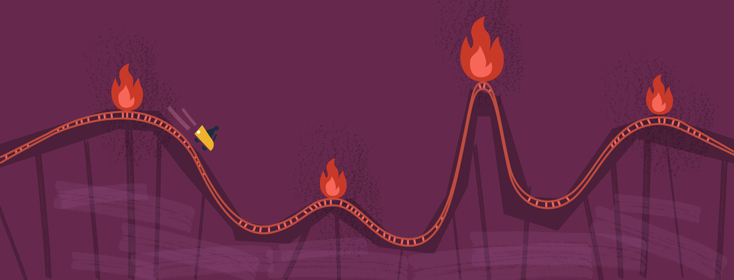Is Life Just One Big Flare?
It can be very hard to know for sure if you will ever feel better. The cycle of ups and downs, good days and bad days with psoriatic arthritis tends to often leave us with one big question. Is life just one big flare? Have I been flaring for months or will things just get worse? Is there any hope that it might actually get better?
What the heck is a flare?
I find it very hard to accurately define what a flare actually is. When asked, the best that I have to offer is that a flare is a period of time when you feel worse than other times. I know, I know, I can’t possibly get more vague than that. And I often think, I feel bad ALL the time. How can I possibly know when it is “worse?”
Can you tell from blood work?
Some people find that their blood work might reveal when they are having a flare (judging by increased levels of inflammation found in the blood). But more often than not, they are the exception since many people with psoriatic arthritis don’t exhibit higher inflammation markers in their blood. Unlike many people with the close cousin, rheumatoid arthritis.
Every person is different
What makes it even more difficult to define a flare is that each individual’s experience of psoriatic arthritis and it’s symptoms is totally unique. For example, if it takes me more than two hours to get moving in the morning, then I can usually bet I’m headed for a flare day. Meaning that I should plan to get very little, if anything, accomplished. But for someone else, getting moving at all, even after more than two hours, they might consider a “good” day.
Riding the waves
The longer you live with psoriatic arthritis, you will see (at least in my experience) that there are certain peaks and valleys to the pain and fatigue of PsA. If you were to chart it, you might notice sort of a wave-like pattern. Whereas, the higher points of the chart will show you your “flares” and the lower parts will show you the days with slightly less pain. In fact, I’m such a nerd, that I did just that before my latest doctor appointment. And proudly limped my way into her office, multi-colored chart in hand, ready to talk. I figured it told my doctor a lot more about how I was doing than the stupid pain scale.
Keep the switch set to low
Another way that I often think does a good job of explaining the wave pattern of a flare is like a dimmer switch. This particular one came to my mind when I was trying to figure out if I the current medicine I was trying was working or not. In my heart, I thought that if the medicine was “working” then I would magically feel back to my old self. Alas, that was not the case. But I did learn to compare how my medicine is working with a dimmer switch.
When you have a dimmer switch, there is always electricity (pain) running to the switch. Sometimes, the dimmer is set really high, the lights are bright, and the electricity (pain) levels are super high. Other times, for example when the medicine is working, the dimmer is set lower. The lights are low and the electricity (pain) flowing to the outlet is dim. The reason I like this so much is that it really shows that the pain is always there, hanging out in the background, ready to rear its ugly head. There are times when it is brighter, times when it is dimmer, but it is always there to some degree.
Keep fighting the good fight
That’s what it comes down to, doesn’t it? It is always there. So, yes, my life might be one big flare. I will constantly be fighting the inflammation, fighting for control over my own body. But, if I have a few days when I feel like I’m NOT in one big flare, then I call that a win. For now, I’ll take it.

Join the conversation